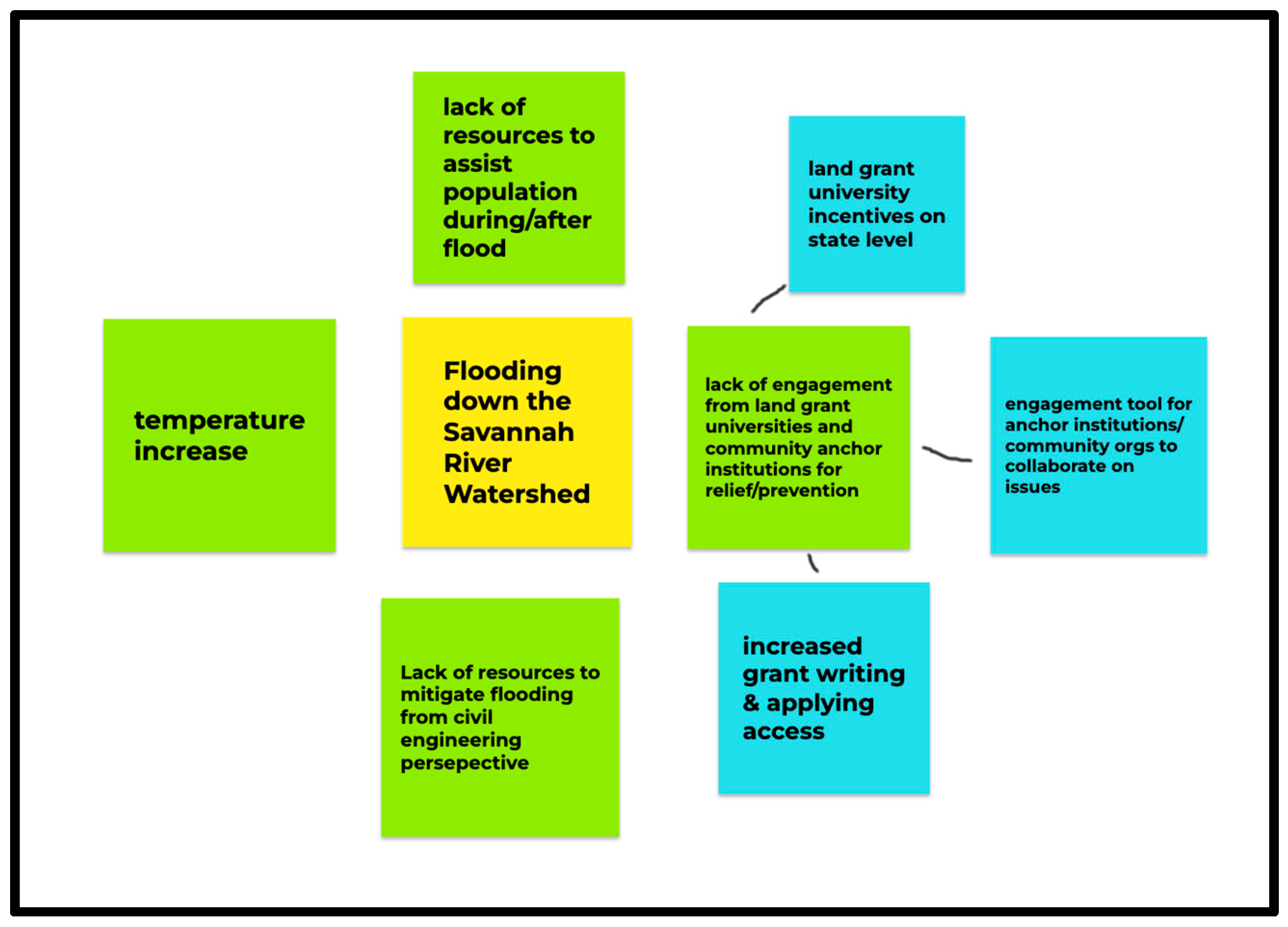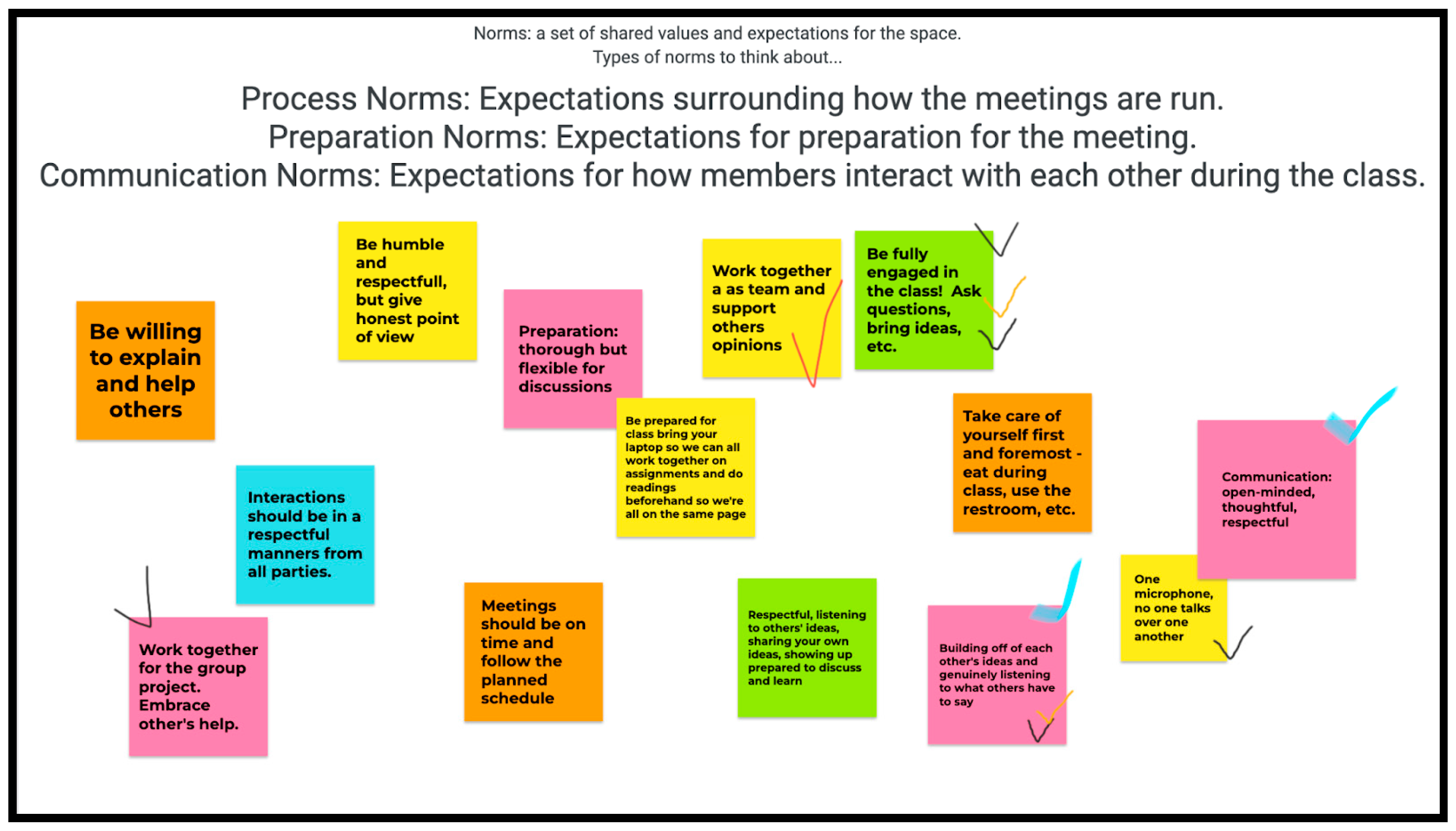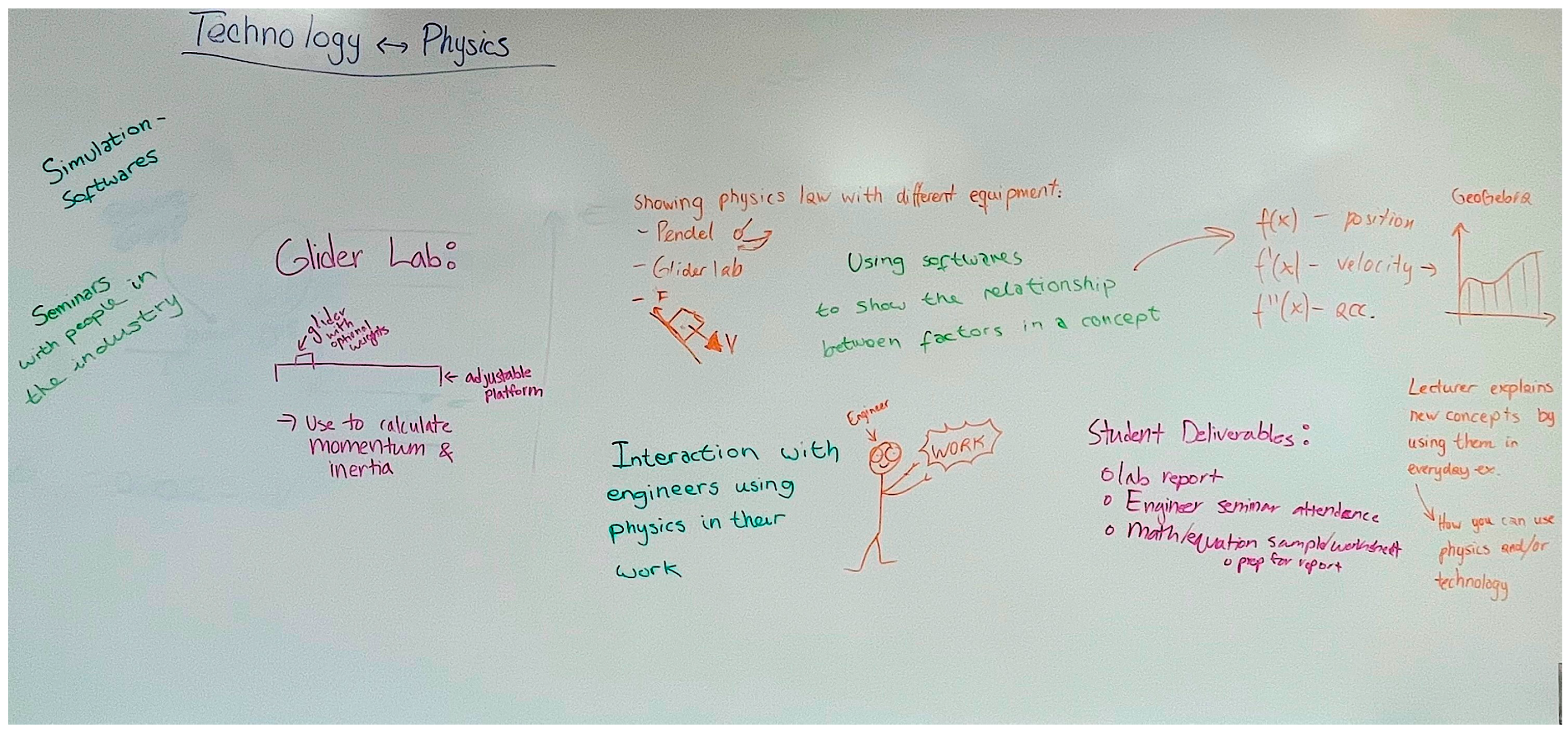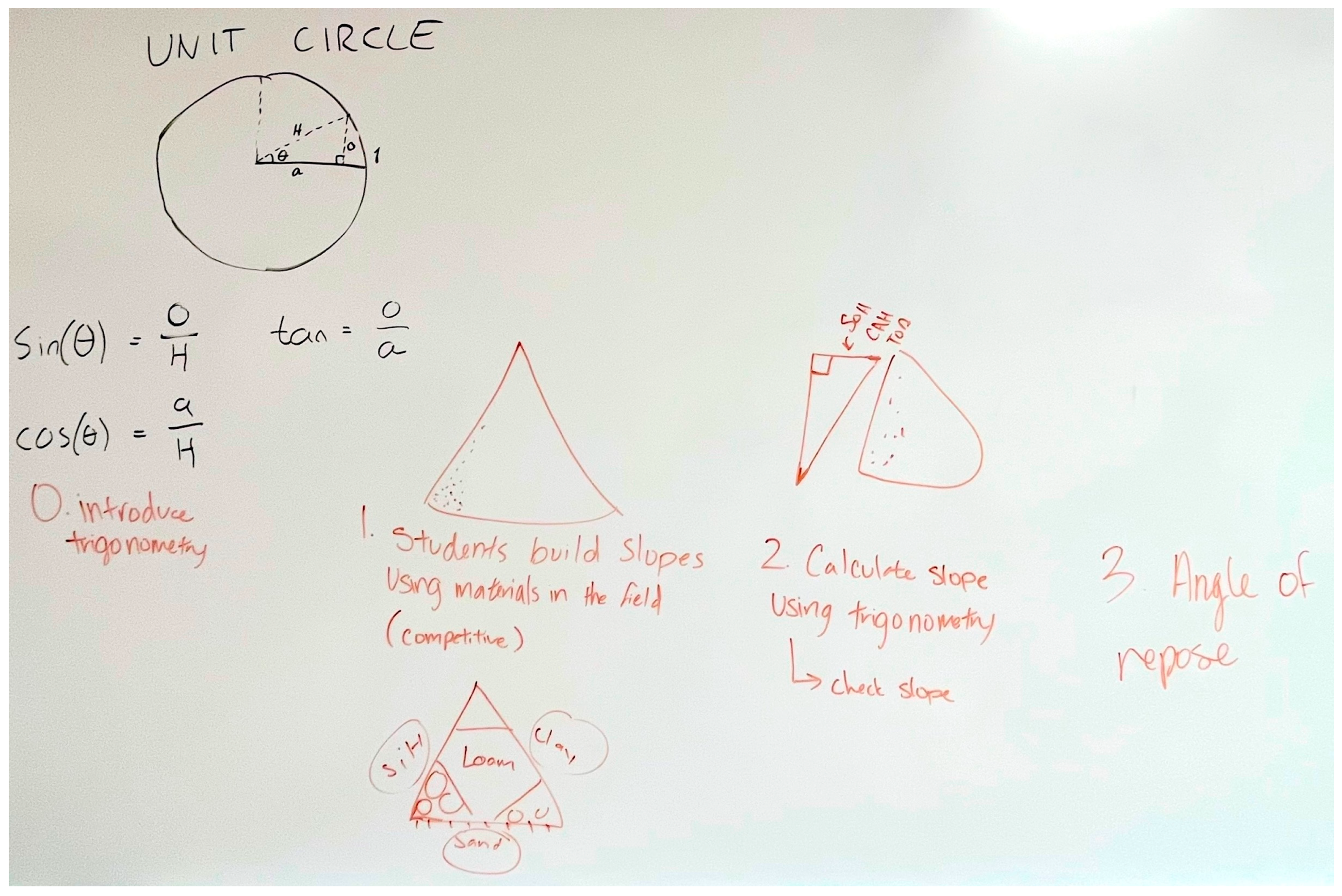Project-Based Learning in Interdisciplinary Spaces: A Case Study in Norway and the United States
Abstract
1. Introduction
- Student Engagement: How did exchange students actively participate as partners in the project-based learning process to create an interdisciplinary STEM lesson integrating mathematics and environmental science concepts?
- Implementation: What were the key instructional barriers and supports encountered when implementing a project-based interdisciplinary STEM lesson where students were involved as co-creators?
- Conceptual Impact: How did participation in the project-based lesson development process influence exchange students’ understanding of interdisciplinary STEM education and its practical applications?
2. Conceptual Framing and Background
2.1. Project-Based Learning: Design Elements
2.2. Connection to Place-Based Education
2.3. Infusion of Lesson Study
2.4. Engaging Students as Partners in Curriculum Development
2.5. Project-Based Learning: Teaching Practices
3. Methods
3.1. Data Context
3.2. Course Description
3.3. Participants
3.4. Study Design
3.5. Data Collection
3.6. Data Analysis
3.7. Validity and Reliability
4. Results
4.1. Students as Decision Makers and Lesson Architects
“One problem that affects the Savannah River Watershed and the surrounding communities is heavy pollution into the basin…Communities are affected by this problem because it damages the aesthetic of the environment, but also because pollution can cause blockages that can contribute to things like flooding.”Florence
4.2. Effective Instructional Supports and Barriers
4.2.1. Create a Welcoming and Collaborative Culture
4.2.2. Scaffold Activities Responsive to the Lesson Architect’s Needs
4.2.3. Additional Structure to Assist the Lesson Architects in Decision Making
4.3. Multifaceted Understanding of Interdisciplinary STEM Education
4.3.1. Expanding Knowledge of Environmental Science
4.3.2. Multiculturalism within Interdisciplinary STEM Education
4.3.3. Understanding of Learning Theories
4.3.4. Engagement in Educational Research
“The exposure to various theories through reading research papers has been crucial in broadening my understanding for conducting research. Delving into these papers has not only enhanced my theoretical knowledge but has also offered practical insights into the methodologies employed in research. It’s even more fascinating to witness how these theories come to life through the implementation of the algal bloom lesson.”Sophia
4.3.5. Broadening the Understanding of Instructional Practices
5. Discussion
5.1. Facilitate Effective Communication
5.2. Lesson Architect-Centered: Focus on the Interests, Experiences, and Knowledge of the Lesson Architects
5.3. Include Authentic Engagement with Interdisciplinary STEM Education
5.4. Future Directions for Project-Based Learning with Students as Partners
6. Conclusions
Supplementary Materials
Author Contributions
Funding
Institutional Review Board Statement
Informed Consent Statement
Data Availability Statement
Acknowledgments
Conflicts of Interest
References
- King, A. From Sage on the Stage to Guide on the Side. Coll. Teach. 1993, 41, 30–35. [Google Scholar] [CrossRef]
- Gruenewald, D.A. The Best of Both Worlds: A Critical Pedagogy of Place. Educ. Res. 2003, 32, 3–12. [Google Scholar] [CrossRef]
- Buck Institute for Education. Gold Standard PBL: The Essential Project Design Elements. 2022. Available online: https://my.pblworks.org/resource/document/gold_standard_pbl_essential_project_design_elements (accessed on 27 February 2024).
- Buck Institute for Education. Gold Standard PBL: Project Based Teaching Practices. 2019. Available online: https://my.pblworks.org/resource/document/gold_standard_pbl_project_based_teaching_practices1 (accessed on 27 February 2024).
- Krajcik, J.S.; Shin, N. Project-based learning. In The Cambridge Handbook of the Learning Sciences, 2nd ed.; Sawyer, R.K., Ed.; Cambridge University Press: Cambridge, UK, 2014; pp. 275–297. [Google Scholar]
- Condliffe, B. Project-Based Learning: A Literature Review; Working Paper; MDRC: New York, NY, USA, 2017. [Google Scholar]
- Yemini, M.; Engel, L.; Ben Simon, A. Place-based education–A systematic review of literature. Educ. Rev. 2023, 1–21. [Google Scholar] [CrossRef]
- Van den Beemt, A.; MacLeod, M.; Van der Veen, J.; Van de Ven, A.; Van Baalen, S.; Klaassen, R.; Boon, M. Interdisciplinary engineering education: A review of vision, teaching, and support. J. Eng. Educ. 2020, 109, 508–555. [Google Scholar] [CrossRef]
- Lubicz-Nawrocka, T. From partnership to self-authorship: The benefits of co-creation of the curriculum. Int. J. Stud. Partn. 2018, 2, 47–63. [Google Scholar]
- Ngereja, B.; Hussein, B.; Andersen, B. Does Project-Based Learning (PBL) Promote Student Learning? A Performance Evaluation. Educ. Sci. 2020, 10, 330. [Google Scholar] [CrossRef]
- Lewis, C.C.; Tsuchida, I. A Lesson Is Like a Swiftly Flowing River: How Research Lessons Improve Japanese Education. Improv. Sch. 1999, 2, 48–56. [Google Scholar] [CrossRef]
- Stigler, J.W.; Hiebert, J. The Teaching Gap: Best Ideas from the World’s Teachers for Improving in the Classroom; The Free Press: New York, NY, USA, 1999; pp. 103–128. [Google Scholar]
- Larmer, J.; Mergendoller, J.R. Gold Standard PBL: Essential Project Design Elements; Buck Institute for Education: Novato, CA, USA, 2015; pp. 1–4. [Google Scholar]
- Darling-Hammond, L.; Barron, B.; Pearson, P.D.; Schoenfeld, A.H.; Stage, E.K.; Zimmerman, T.D.; Cervetti, G.N.; Tilson, J.L. Powerful Learning: What We Know about Teaching for Understanding; Jossey-Bass: Hoboken, NJ, USA, 2008. [Google Scholar]
- Yu, H. Enhancing creative cognition through project-based learning: An in-depth scholarly exploration. Heliyon 2024, 10, e27706. [Google Scholar] [CrossRef] [PubMed]
- Freire, P. Pedagogy of the Oppressed, 30th Anniversary ed.; Continuum: New York, NY, USA, 2005; pp. 43–70. [Google Scholar]
- Williams, M.K. John Dewey in the 21st century. J. Inq. Action Educ. 2017, 9, 7. [Google Scholar]
- Lubicz-Nawrocka, T.; Bovill, C. Do students experience transformation through co-creating curriculum in higher education? Teach. High. Educ. 2023, 28, 1744–1760. [Google Scholar] [CrossRef]
- Larmer, J.; Mergendoller, J.; Boss, S. Setting the Standard for Project Based Learning; ASCD: Alexandria, VA, USA, 2015; pp. 1–54. [Google Scholar]
- Mergendoller, J.R.; Thomas, J.W. Managing project based learning: Principles from the field. In Proceedings of the 2000 Annual Meeting of the American Educational Research Association, New Orleans, LA, USA, 24–28 April 2000. [Google Scholar]
- Merriam, S.B. Qualitative Research and Case Study Applications in Education, 2nd ed.; Jossey-Bass Publishers: San Francisco, CA, USA, 2009; pp. 39–55. [Google Scholar]
- Yazan, B. Three Approaches to Case Study Methods in Education: Yin, Merriam, and Stake. Qual. Rep. 2015, 20, 134–152. [Google Scholar] [CrossRef]
- Brown, P.A. A review of the literature on case study research. Can. J. New Sch. Educ./Rev. Can. Jeunes Cherch. Cherch. Educ. 2008, 1, 1–13. [Google Scholar]
- Braun, V.; Clarke, V. Thematic analysis. In APA Handbook of Research Methods in Psychology: Research Designs: Quantitative, Qualitative, Neuropsycholog-Ical, and Biological; Cooper, H., Camic, P.M., Long, D.L., Panter, A.T., Rindskopf, D., Sher, K.J., Eds.; American Psychological Association: Washington, DC, USA, 2012; Volume 2, pp. 57–71. [Google Scholar]
- Bloom, B.S. Taxonomy of Educational Objectives, Handbook: The Cognitive Domain; David McKay Company, Inc.: New York, NY, USA, 1956. [Google Scholar]
- Chang, Y.; Choi, J.; Şen-Akbulut, M. Undergraduate Students’ Engagement in Project-Based Learning with an Authentic Context. Educ. Sci. 2024, 14, 168. [Google Scholar] [CrossRef]
- Kaya, T.; Bowlyn, K.N. Building an Innovative Engineering Curriculum from the Ground Up: Lessons and Success Stories Paper. In Proceedings of the 2024 ASEE North East Section, Fairfield, CT, USA, 19–20 April 2024. [Google Scholar]
- Tsui, E.; Dragicevic, N.; Fan, I.; Cheng, M. Co-creating curriculum with students, teachers, and practitioners in a technology-enhanced environment. Educ. Tech. Res. Dev. 2024, 72, 869–893. [Google Scholar] [CrossRef]
- Abuhassna, H.; Al-Rahmi, W.M.; Yahya, N.; Zakaria, M.A.Z.M.; Kosnin, A.B.M.; Darwish, M. Development of a new model on utilizing online learning platforms to improve students’ academic achievements and satisfaction. Int. J. Educ. Technol. High. Educ. 2020, 17, 38. [Google Scholar] [CrossRef]






| Pseudonym | Position | Brief Biography |
|---|---|---|
| Florence | Undergraduate Lesson Architect (United States) | She is a Bachelor of Science student in Civil Engineering at Isunigu University. |
| Maria | Undergraduate Lesson Architect (Norway) | She is a Bachelor of Science student in Civil Engineering at the University of Egðir. |
| Red | Graduate Lesson Architect (Norway) | She is a Master of Science student in Civil Engineering and Industrial Economy and Technology Management at the University of Egðir. |
| Salix | Graduate Lesson Architect (United States) | She is a recent graduate with a Master of Science in Biological Sciences from Isunigu University. Her research focus is plant ecology. |
| Sophia | Graduate Lesson Architect (Norway) | She is a Master of Science student in Industrial Economy and Technology Management with a Bachelor of Science degree in Electronics and Electrical Engineering from the University of Egðir. |
| Gigi | Graduate Student Teacher of Record; Lead Researcher (United States) | She is a current PhD student in Engineering and Science Education at Isunigu University with previous secondary mathematics and science teaching experience, as well as experience in Biomedical Engineering. |
| Saoirse | Faculty Co-Instructor (United States) | She is an assistant professor at Isunigu University with a joint appointment in the Department of Engineering and Science Education and the Department of Environmental Engineering and Earth Sciences. |
| Maximilian (Max) | Faculty Co-Instructor (United States) | He is an assistant professor at Isunigu University in the Department of Engineering and Science Education. |
| Learning Objective | Description |
|---|---|
| Learning Objective 1 | Students will plot various types of algal bloom data and conduct multiple statistical tests on data derived from different locations, including the Savannah River Watershed and Norwegian Coastline. |
| Learning Objective 2 | Students will be able to interpret the results of the graphs and statistical tests by making connections within and across data sets to draw conclusions about how algal blooms grow and the impact algal blooms have on the environment. |
Disclaimer/Publisher’s Note: The statements, opinions and data contained in all publications are solely those of the individual author(s) and contributor(s) and not of MDPI and/or the editor(s). MDPI and/or the editor(s) disclaim responsibility for any injury to people or property resulting from any ideas, methods, instructions or products referred to in the content. |
© 2024 by the authors. Licensee MDPI, Basel, Switzerland. This article is an open access article distributed under the terms and conditions of the Creative Commons Attribution (CC BY) license (https://creativecommons.org/licenses/by/4.0/).
Share and Cite
Bolick, M.A.; Thomassen, M.; Apland, J.; Spencer, O.; Nicole, F.; Tran, S.K.N.; Voigt, M.; Lazar, K.B. Project-Based Learning in Interdisciplinary Spaces: A Case Study in Norway and the United States. Educ. Sci. 2024, 14, 866. https://doi.org/10.3390/educsci14080866
Bolick MA, Thomassen M, Apland J, Spencer O, Nicole F, Tran SKN, Voigt M, Lazar KB. Project-Based Learning in Interdisciplinary Spaces: A Case Study in Norway and the United States. Education Sciences. 2024; 14(8):866. https://doi.org/10.3390/educsci14080866
Chicago/Turabian StyleBolick, Margaret Ann, Malena Thomassen, Jennifer Apland, Olivia Spencer, Fantasi Nicole, Sonja Kim Ngan Tran, Matthew Voigt, and Kelly Best Lazar. 2024. "Project-Based Learning in Interdisciplinary Spaces: A Case Study in Norway and the United States" Education Sciences 14, no. 8: 866. https://doi.org/10.3390/educsci14080866
APA StyleBolick, M. A., Thomassen, M., Apland, J., Spencer, O., Nicole, F., Tran, S. K. N., Voigt, M., & Lazar, K. B. (2024). Project-Based Learning in Interdisciplinary Spaces: A Case Study in Norway and the United States. Education Sciences, 14(8), 866. https://doi.org/10.3390/educsci14080866






